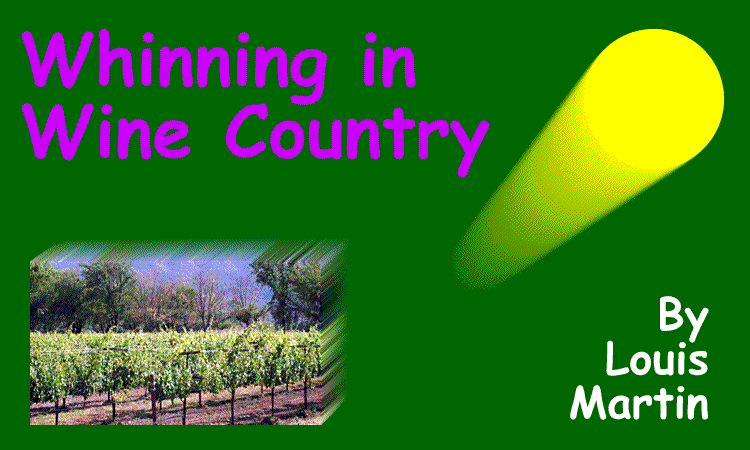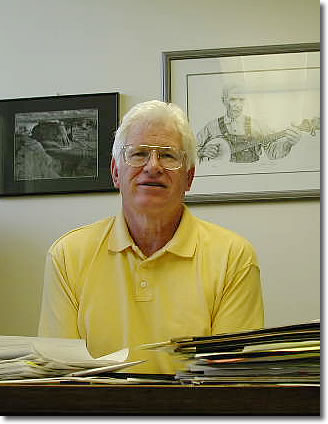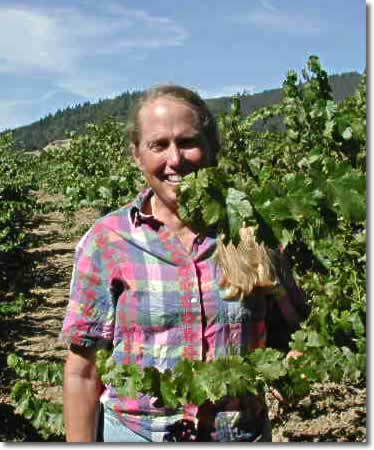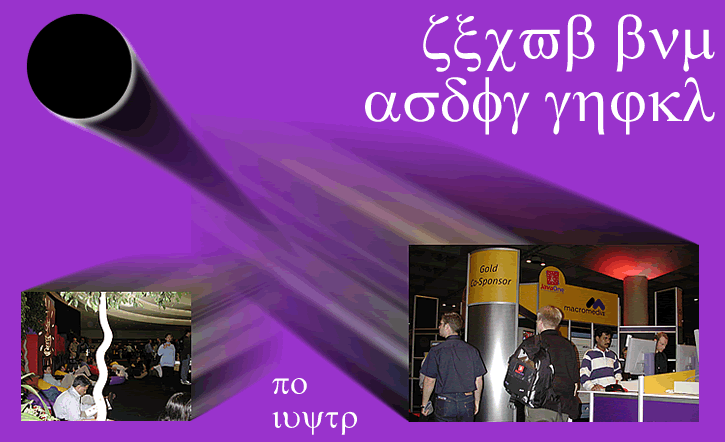Home | City Notes | Restaurant Guide | Galleries | Site Map | Search | Contact

Computer shows are a lot of fun, especially when they are over. Those big ones at Moscone Center in San Francisco are especially daunting, dizzying, discombobulating ... or something. See what I mean? They leave you groping for the right word and never quite finding it. Anyway, when they are over you will need a recovery plan. Part of my recovery plan always includes a little getaway, along with a bit of the grape.
So, with "Expo X" over and the weather back to normal following a hot spell, it is a great pleasure to be heading up Lombard Street towards the Golden Gate and escaping to the north. Now here is a trick I have to restore perspective: From the middle of the Golden Gate I glance for a moment out to sea. Try it. You will get a refreshing sense of another world out there, a world far away over a vast expanse of water. Picture a warm and friendly people working the land and in balance with nature. But you don't have to do go this far: Just cross the bridge on a Monday when traffic is light and you will find yourself relaxing, thinking non-digital, and even enjoying the ride.
As you approach Sonoma county and "ag land," you may even experience a little sense of pleasure. My, what a lot of wine grapes, you may find yourself saying; or my, what a lot of wine. Mile after mile of green staked rows of vines crisscross newly graded hills. But do they plant anything else here these days, you may begin to wonder. Maybe, but if so, it is out of sight and probably not legal.
But now as you approach Mendocino and take the turnoff to 128 and the coast, with its promise of refreshing coastal fog, you may find yourself even lightening up more. Highway 128 runs through the Anderson Valley, one of Mendocino's prime wine-growing regions these days. While Anderson valley still produces apples and some crops other than wine grapes, grapes rule. If you have any doubts about that, just consider the number of wine-tasting rooms along the highway. Only Gowains offers a taste of anything else from Anderson Valley, and it is a rickety shack but a few feet from the road selling apples. No artsy signs—just plain ones—and no colorful flags beckon you.
Drive in at night, and the situation is even clearer as you drive along the now-well-paved road toward the coast. Remember the days when you shared the road with sheep and a yellow-painted divider line was an occasional thing? If so, you are getting old. The night drive is eerie as your lights illuminate sign after sign advertising winery after winery, tasting room after tasting room. Handley, Husch, Navarro; Brutocco, Roederer Estates; Greenwood Ridge, Christine Woods, Claudia Springs ... Bacchus would love this place, though he might have to put on more clothes; Mendocino is cold at night.
Grapes Everywhere
Yes, there are grapes everywhere. And the fox would find them easy to reach and not a one of them sour.
Dave Bengston, Agriculture Commissioner
of Mendocino County, confirms what my eyes have already told me: Wine production has skyrocketed in Mendocino. Officially
there are about 15,000 acres of wine grapes in the county; unofficially
there are probably about 20,000. That is more than half of the ag land
in the county now planted in wine grapes.
already told me: Wine production has skyrocketed in Mendocino. Officially
there are about 15,000 acres of wine grapes in the county; unofficially
there are probably about 20,000. That is more than half of the ag land
in the county now planted in wine grapes.
While wine has increased, other crops have been declining. Bengston sounds a bit sad about that: "There was a time when we had close to 700 acres of prunes; we had 700 acres of walnuts." Those are all gone, and apples, which were big business a few years back, he calls a "dying industry." There are only a couple of major apple growers left in Mendocino county. Pears are the runner up to wine, but according to Bengston, "pears are coming off the three worst years they've ever had back to back."
Wine, however, is doing just fine. Even some timber land, much to the consternation of environmentalists, is being converted to wine production. Though wine is now dominant, Bengston says, "We are not completely a monoculture, not like Napa." If you count timber, however, it is number one, with over a million acres in production.
Is Bengston beginning to feel like the wine commissioner in Mendocino? Not really, he says. He has other duties and he maintains his sense of balance. "There are days when I don't even get involved in it. Yesterday was grading committee ... there are things like sudden oak death that we are dealing with ... some days are weights and measures days." There is more going on in Mendocino than just wine, despite what you might think from road signs, and Bengston sounds glad about that. Still, wine is a 90-million-dollar business and he keeps his eye on it, as does the fox, who is beginning to wonder if dinner can be had in this county. Some meat would go well with that Merlot, that Petit Verdot.
Cattle seems to be the one stable industry, with cows still being cows and of only moderate interest to tourists and cow consumers. Wine is different; the wine and tourist industries partially feed off each other. Says Bengston, "The tourists come in because they are attracted to the wine." At least some of them. And since they are in Mendocino, they spend the night. And since they spend the night, they eat ... In short, more than one cash register registers.
"Organic" is a big word in Mendocino county, and there is a larger-than-average percent of organic grapes grown in the county: over 20%. But the wine industry is also an "industry," and says Bengston, "A lot of the growers and wineries wouldn't do it if there wasn't a market for it."
Bengston identifies three different types of organic growers: Those who do it because they believe in it; those who do it because they have contracts to grow organic grapes; and those who do it that way because they have always done it that way. With the first group, it is a matter of philosophy. Of the second group, Bengston says: "The Winery comes out and they have been buying their grapes for five years, and they come out and they say, 'Okay, next year we want you to be organic.' Boom. The grower becomes organic." Of the last group, those who do it that way because they always have: "There are people who are organic in this county who have never really given it much thought". He says it is not hard to do: "You can grow grapes without putting on anything but sulfur pretty easy in this county, and sulfur is organic."
True Believer
Primary among the believers is Frey Vineyards in Redwood Valley. Frey's grapes are grown according to the biodynamic principles of the Demeter Association, which offers a higher level of organic certification than the common California Certified Organic Farmers program. Biodynamic agriculture involves a profound philosophy of the earth, nature, healing and vitality applied to growing plants.
 "We
do everything," says Katrina Frey, "that a good organic farmer does,
and then beyond that we apply very specific preparations that are made from
the plant and mineral kingdom." These are applied certain times of the
year according to moon cycles.
"We
do everything," says Katrina Frey, "that a good organic farmer does,
and then beyond that we apply very specific preparations that are made from
the plant and mineral kingdom." These are applied certain times of the
year according to moon cycles.
Now do not laugh or even raise an eyebrow when someone in Mendocino starts talking about moon cycles. Spend a week or so there, and you too will probably be talking the same language, perhaps even carrying tide charts or astrological diagrams and charting your own biorhythms.
"The ultimate goal is the soil life," says Frey. In addition to the "preparations," composting and careful observation of the plants is also part of the formula for health.
Is it more trouble? Indeed it is, but says Frey, "You don't have to call it 'trouble.'" "Work," she indicates, is a better word for it. "You observe the plant, and with experience and observation you recognize the natural forces at work and respond to them."
Is it worth it? Try a bottle of Frey's 1999 Syrah. Even the fox would be impressed with these grapes.
With the additional "work" involved in organic production, especially in biodynamic production, there is concern about new labelling requirements to be imposed by the USDA on organic products. The new labelling will be required by August 2002 for food and beverages labelled as organic, and other labelling will not be allowed, although the USDA says specific claims about the ingredients may be made.
Thus a bottle of Gallo wine containing grapes grown on dead soil in Fresno might have the same labelling as a bottle of Petit Sirah with grapes grown at Frey Vineyards in Mendocino. Says Frey, "What they have established is a minimum standard of organic practices, and you are not allowed to claim a higher standard than that."
While small organic farms have done the pioneering work in organic food production, large corporate farming operations will now be able to claim equal footing with them by meeting minimal federal standards. It is not surprising that some are upset by this. While the playing field has been levelled, it has also been lowered.
One wrinkle in the operation for organic-wine producers, however, is that labelling of organic wine comes under the direct jurisdiction of the Bureau of Alcohol, Tobacco, and Firearms, and the bureau has not made up its mind what it is going to require. It does state that it won't be involved with enforcement of matters related to organic production, presumably leaving that up to the USDA. This leaves organic wine producers in a dark, cool cellar wondering what is going to happen.
While the organic label is important for wine, it does not seem to be as important as the labelling, say, of pears, apples or cherries as "organic." It may be that buying a bottle of organic wine is a little like buying a bottle of organic rat poison; if you are buying something that is at least partly toxic, it may not seem very important that it be organic.
But there may be another reason why organic is important in wine production. There is the labelling of the bottle, which is the major concern of the USDA; but there is also the designation of the grapes as organic, and hence the vineyards. John Enquist, Executive Director of the Mendocino Winegrowers Association, sees the significance of "organic" more in the vineyards and the grapes themselves. "I think that organics are going to play a major role in the wine industry ... just because of stewardship of the land."
He admits that the organic label has not played a major role with the consumer when it comes to wine. And that may harp back to the organic rat poison theory. While Demeter might care, Bacchus might not even read the label.
Bonterra and "Mugwump"
The Fetzer organic label is Bonterra, meaning good earth. Take 101 north to Hopland, then head east on 175 and you will soon see signs for Fetzer Vineyards. Here you will find the main tasting room for Fetzer, a Fetzer bed-and-breakfast operation, and a small deli-type restaurant. The tasting room is fine, except that it is filled with many other items for sale other than wine—Fetzer hats, T-shirts ... The result is distraction. And why a bed and breakfast? Who knows. At the tasting bar you will find you're standing next to people with no special interest in wine, but rather with tourists "doing the wine thing." If you want to hear intelligent comments about the wine, you had better make them yourself.
Nevertheless the wine is good, especially the Bonterra label. The actual Bonterra Vineyards appear to be located some miles to the north, but the Bonterra model garden is a short walk from the tasting room. It is in fact worth visiting: first for the many bursts of color and the variety; second for the mad buzzing of insects. In its gentle surroundings of hills, vineyards and blue skies, its beauty is intense. However, you won't see many wine grapes in the garden. The idea is biodiversity and natural pest control. I did, however, notice bug traps around the small amount of wine grapes growing in the garden. Apparently biodiversity didn't totally do the job.
According to the literature, the garden contains over 1000 herbs, flowers, fruits and vegetables. The literature also talks about the use of cover crops in the vineyards, natural fertilizers and so on. All of this makes good reading, but I did not see the use of cover crops in the main vineyards, though they may be used at some other time of the year.
In the berry section of the garden
you will find the delightful Thimbleberry. Thimbleberries, which have a light-red, cap-like berry that peels off, are normally found in moist
Redwood forests along the coast. Here they looked just a little bit wilted.
Pioneer women are said to have used the leaves to redden their cheeks instead
of rouge. Whether this attracted pioneer men, who probably drank more whiskey
than wine, the literature does not say.
have a light-red, cap-like berry that peels off, are normally found in moist
Redwood forests along the coast. Here they looked just a little bit wilted.
Pioneer women are said to have used the leaves to redden their cheeks instead
of rouge. Whether this attracted pioneer men, who probably drank more whiskey
than wine, the literature does not say.
There are many other kinds of berries, edible flowers, rows of Expalier Apples, culinary herbs and tea, persimmons, a mulberry garden, and some wonderful, huge old oak trees that, so far, have not been hit with Phytophthora, or sudden oak death. Hummingbirds dart everywhere, as though time were of the essence in this garden estate, while butterflies pursue slower, floppier paths among the many colorful plants.
At a bench by the pavilion and an artificial lake a couple sits drinking a bottle of wine, oblivious to everything but themselves and their conversation. Newlyweds? They look like it. Strange that there is no insect by that name.
I walk back to the tasting room, buy bottles of Bonterra Sanviovese and Rousanne, then head back to Hopland. On the way back at the Russian River, I pull over and walk along a dirt road between the vineyards and the river bank, which is covered in thick vegetation. Through a gap in the vegetation I see that the river is green and scummy. Suddenly I hear car wheels on the dirt road, turn, and see a car pull up and two women get out with plastic bags. They start pulling the branches off a pale-looking plant by the river bank. They look Native American.
I walk over and ask what they are picking. Both smile warmly. The older one looks like the mother. "Mugwump," I believe is what the older one says. "Good for pain." But I can't be sure of the name now; the closest I get from looking it up is "mugwort." But perhaps they have their own name for it. I remark on the size of the vines in the nearby vineyards. She tells me they are champagne grapes. They fill their bags with mugwump, mugwort, or whatever it is, which is free, kills pain, and is truly organic, even if it is not USDA-certified. I will look for these two at the next computer show, standing off to the side somewhere. They just may be onto something I am missing.

Home | City Notes | Restaurant Guide | Galleries | Site Map | Search | Contact